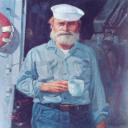Yahoo Answers is shutting down on May 4th, 2021 (Eastern Time) and beginning April 20th, 2021 (Eastern Time) the Yahoo Answers website will be in read-only mode. There will be no changes to other Yahoo properties or services, or your Yahoo account. You can find more information about the Yahoo Answers shutdown and how to download your data on this help page.
Trending News
Why wasn't there any air support at Normandy?
I'm looking for someone who knows the true answer, not just speculation.
How come the Allies didn't carpet bomb the beach-head zone before the Normandy invasion? All those guns on the beach, all those soldiers killed... I was just wondering if there could have been more air support to hit those bunkers and guns before the beach-head. Does anyone know why that didn't happen?
8 Answers
- BoatsBM1Lv 79 years agoFavorite Answer
"Altogether, the tactical air forces had 2,434 fighters and fighter-bombers, together with approximately 700 light and medium bombers available for the Normandy campaign. This force first struck against the Germans during the preparatory campaign prior to D-Day. At D minus 60 days, Allied air forces began their interdiction attacks against rail centers; these attacks increased in ferocity and tempo up to the eve of the invasion itself and were accompanied by strategic bomber raids against the same targets. The bridge campaign, which aimed at isolating the battlefield by cutting Seine bridges below Paris and Loire bridges below Orléans, began on D minus 46. Here, fighter-bombers proved more efficient than medium or heavy bombers, largely because their agility enabled them to make pinpoint attacks in a way that the larger bombers, committed to horizontal bombing runs, could not. The fighter-bombers also had the speed, firepower, and maneuverability to evade or even dominate the Luftwaffe. Though ground fire and (rarely) fighters did claim some attacking fighter-bombers, the loss rate was considerably less than it would have been with conventional attack or dive bombers. By D minus 21, Allied air forces were attacking German airfields within a radius of 130 miles of the battle area and these operations too continued up to the assault on the beachhead."
Air Support on the Beaches
"During the June 6 D-Day assault itself, a total of 171 squadrons of British and AAF fighters undertook a variety of tasks in support of the invasion. Fifteen squadrons provided shipping cover, fifty-four provided beach cover, thirty-three undertook bomber escort and offensive fighter sweeps, thirty-three struck at targets inland from the landing area, and thirty-six provided direct air support to invading forces. The Luftwaffe's appearance was so minuscule that Allied counterair measures against the few German aircraft that did appear are not worth mentioning.
Of far greater importance was the role of aircraft in supporting the land battle. As troops came ashore at Normandy, they made an unpleasant discovery all too familiar to the Marine Corps and Army operating in the Pacific campaign. Despite the intensive air and naval bombardment of coastal defenses, those defenses were, by and large, intact when the invasion force "hit the beach." This was particularly true at OMAHA beach, where American forces suffered serious casualties and critical delays. Despite a massive series of attacks by Eighth Air Force B-17s, B-24s and medium bombers in the early hours of June 6, the invading troops were hung up on the beach. The air commanders themselves had, in fact, predicted that the air and naval bombardments would not achieve the desired degree of destruction of German defensive positions. The Army's general optimism that air would cleanse the beaches before its approach, however, was shattered. Only the subsequent success of fighter-bombers operating against the battlefield would revive the Army's confidence in air support. Indeed, throughout the post-Normandy campaign--and in the Second World War as a whole--the fighter-bomber proved overwhelmingly more valuable in supporting and attacking ground forces in the battle area than did the heavy or even the medium bomber."
Source(s): D-Day 1944 Air Power Over the Normandy Beaches and Beyond Richard P. Hallion Air Force Historian Air Force History and Museums Program 1994 - wichitaor1Lv 79 years ago
There was massive Allied air support for the Normandy landings. Much of it was used to hit areas behind the beaches, destroying rail lines and preventing German reinforcements from reaching the beach area.
To knock out each individual bunker and artillery emplacement would have taken months of reconnaissance, plotting, and bombing to ensure that most of the German fortifications would have been destroyed. Such operations would have surely tipped off the Germans on where the landings were to take place, eliminating any chance for surprise.
- Anonymous9 years ago
Beach defenses are not a standard target for bombing, unless you're planning to attack. The Allies had led the Germans to believe the invasion would be at Calais, so the Germans had concentrated most of their resources there. To continue the rose, they focused their bombing campaign on Calais. To start heavily bombing Normandy would totally ruin the element of surprise.
The lack of accuracy of bombing at the time meant that the loss of the element of surprise was not worth the relatively small amount of damage that could be done to the beach defenses. Instead, the Navy bombarded the beach right before the landing. (By then, the ships were visible, and the element of surprise was of course gone anyway.)
- 9 years ago
As everyone else said, there was. But on D-Day there was heavy cover(fog or smoke) over the beach. The bomber didn't want to take the chance of bombing the soldiers on the beach so they were told to wait 15 to 30 seconds before they dropped their bombs. They ended up bombing behind the beach defenses.
Source(s): Military channel - How do you think about the answers? You can sign in to vote the answer.
- Anonymous9 years ago
well for My experiences the RAF was Bombing Germany round the Clock around Calais
and we also dropped Rupert a dummy paratrooper to draw the Germans away from Normandy
the RAF dropped Paras Behind enemy Lines
Fighter bombers began a new direct support role, operating with the assistance of radio-equipped Forward Air Controllers (FACs). The fighter bombers were on call from "Cab Ranks", orbiting points close to the forward edge of the battle area. From these Cab Ranks, the FACs could very quickly call on air support for any targets of opportunity or threats to the troops in their area. The FACs were both RAF and Army personnel, specially trained to identify targets to the pilots and direct their fire. Also, and seemingly almost permanently, airborne over the beachheads were the Artillery Spotter aircraft. These light aircraft directed fire from naval vessels off-shore initially, before they began directing artillery fire once the regiments were established on land. The light aircraft of the RAF, Army and US were also were the first to operate as airborne FACs, sometimes directing the fighter bombers themselves.
Given the vital supplies now flowing across the channel, the operations of Coastal Command to prevent the interruption of this flow by either German submarines or surface vessels became even more important. The sorties cast an increasingly wider net to catch the submarines and vessels as far as possible from the shipping lanes.
D-Day+1 to end of June
7 June RAF Pigeon ‘Gustav’ was one of two birds to be carried by one of the special Dakotas with the first wave on D-Day. At a crucial period when no signals traffic news was allowed or expected, this particular pigeon made history by bringing back the 1st message from "Taylor of Reuters".
7 June RAF fighters attacked road and railway targets in NW France. A German Panzer Division advancing from Alencon, north of Le Mans, lost over 200 vehicles through air attacks.
7 June The first Allied airstrip in Normandy (B-1) completed at Asnelle, northeast of Bayeux.
Source(s): 9 years in RAF after WW2 to Young to Join during WW2 - Anonymous9 years ago
There was massive air support...we had to have air superiority to have even considered such an undertaking....you have to remember bombing was extremely inaccurate compared with today's smart bombs...I read some where that there were so many bomb craters in and around the big gun emplacements that when our soldiers got to them it made it very hard to figure out where they were on the maps they had and made movement difficult.
- 9 years ago
you see 88s or AA Gun or Anti tank gun. There Positioned Hundreds of them
how would you think an aircraft would pass or target that Bunker
it depends on the infantry on the beach that is why they do a training drill in their beaches
to practice Running through the end of the beach
Source(s): Nothing - Anonymous9 years ago
There was..as well as a massive naval bombardment.
The problem is..just like today...that hardened structures are hard to hit and destroy. And back then they didn't have precision guided munitions or satellite imagery.







